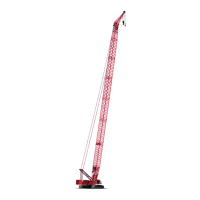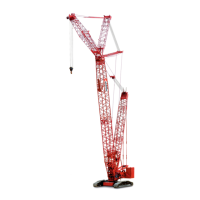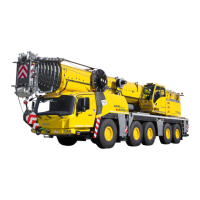Manitowoc Published 05-09-17, Control # 014-28 1-67
16000 SERVICE/MAINTENANCE MANUAL INTRODUCTION
Wheel Assemblies
See Figure 1-59 and Figure 1-60 in the following procedure.
Wheel assembly swing motors allow positioning of MAX-ER
wheels. Before operating any steering switch, make sure the
jacking cylinders are in the correct position for rotating
wheels. The left side wheel assembly items are used for an
example in this section; right side wheel assembly items
operate the same.
The wheel assembly valves have a counterbalance valve at
each motor port. These valves provide smooth operation
when operating. Counterbalance valves also provide relief
protection. The wheel assembly three position spool valves
are motor spooled where both motor ports and tank port of
valve spool section are connected in center position.
The crane accessory system pressure sender monitors
system pressure to wheel assembly motors.
Left and right wheel assembly encoders detects wheel
position and direction of movement. Node-1 receives this
information as two out-of-phase square wave input voltages
that are converted to counts. Information screen in
operator’s cab indicates wheel positions in degrees.
Power is available to hand-held wireless remote control
when engine is running, MAX-ER function mode is selected,
and power button is pressed. Wheels can not be moved until
electrical cables and hydraulic lines are connected between
rear of crane and telescopic beam of MAX-ER.
When operating, the right travel handle can operate wheel
assembly position when travel is parked and a MAX-ER
chart is selected. Moving the handle forward moves wheel
assemblies to straight position. Moving the handle back
moves wheel assemblies to swing position. The right travel
wheel assembly operation is similar to hand-held wireless
remote control operation described next.
Wheel Steering Clockwise
When left wheel steering switch is moved and held in
clockwise position, an input signal from wireless transmitter
is sent to a receiver on the crane. The receiver sends the
input signal to Node-1 controller. Node-7 sends a 24 volt
output to enable the left wheel assembly solenoid (HS-82)
and shifts the valve to rotate left side wheels in a clockwise
direction.
Node-7 also sends a 24 volt output to enable the left wheel
assembly brake solenoid HS-86 to release the internal
brakes on both left wheel swing shafts.
Node-3 controller also sends a variable zero to 24 voltage to
enable proportional relief solenoid HS-68 to provide
approximately 4,500 psi (310 bar) pressure to wheel
assembly.
Hydraulic pressure from accessory pump flows through
pressure control pilot valve, six bank manifold valve, and
enters free-flow check valve section of counterbalance
valve. Fluid pressure turns motor output shaft so wheels
rotate in a clockwise direction.
Return hydraulic fluid from output side of hydraulic swing
motor flows through flow control relief valve, six bank
manifold valve before returning to crane hydraulic tank
through return line.
When wheel position is reached, release wheel steering
switch. When switch is released Node-7 sends an input
signal to Node-1 controller. Node-1 controller sends a zero
volt output to disable the left wheel brake solenoid HS-87
and apply the internal brakes on both left wheel swing shafts.
After brakes are applied, Node-1 controller also sends a zero
volt output to disable the left wheel Assembly solenoid HS-
83, to shift the valve to center position.
Node-3 controller sends a zero volt output to accessory
system proportional relief solenoid HS-68 to provide
approximately 3,000 psi (207 bar) system pressure.
Wheel Steering Counter-Clockwise
When left wheel steering switch is moved and held in
counter-clockwise position, an input signal from wireless
transmitter is sent to a receiver on the crane. The receiver
sends the input signal to Node-1 controller. Node-7 sends a
24 volt output to enable the left wheel Assembly solenoid
HS-83 and shifts the valve to rotate left side wheels in
counter-clockwise direction.
Node-3 controller also sends a variable zero to 24 voltage to
enable proportional relief solenoid HS-68 to provide
approximately 4,500 psi (310 bar) pressure to wheel
assembly.
Hydraulic pressure from accessory pump flows through
pressure control pilot valve, six bank manifold valve, and
enters free-flow check valve section of counterbalance
valve. Fluid pressure turns motor output shaft so wheels
rotate in a clockwise direction.
When wheel position is reached, release wheel steering
switch. When switch is released Node-7 sends an input
signal to Node-1 controller. Node-1 controller sends a zero
volt output to disable the left wheel brake solenoid HS-87
and apply the internal brakes on both left wheel swing shafts.
After brakes are applied, Node-1 controller also sends a zero
volt output to disable the left wheel Assembly solenoid HS-
83, to shift the valve to center position.
Node-3 sends a variable voltage output to accessory system
proportional relief solenoid HS-68 to provide approximately
3,000 psi (207 bar) system pressure.

